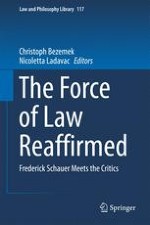2016 | OriginalPaper | Buchkapitel
Coercion and the Normativity of Law: Some Critical Remarks on Frederick Schauer’s The Force of Law
verfasst von : Thomas Bustamante
Erschienen in: The Force of Law Reaffirmed
Aktivieren Sie unsere intelligente Suche, um passende Fachinhalte oder Patente zu finden.
Wählen Sie Textabschnitte aus um mit Künstlicher Intelligenz passenden Patente zu finden. powered by
Markieren Sie Textabschnitte, um KI-gestützt weitere passende Inhalte zu finden. powered by
